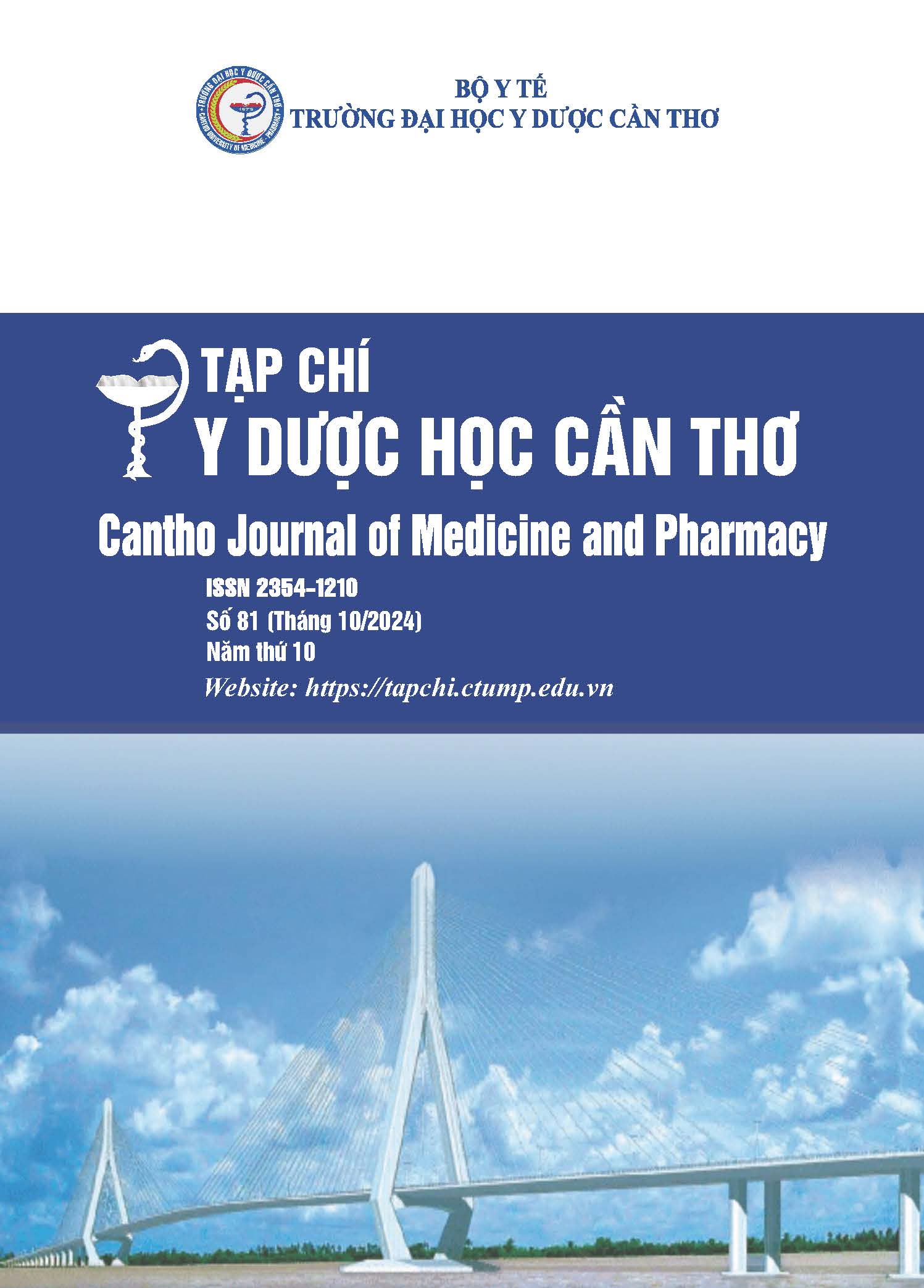INTERVENTION OUTCOMES FOR CHILDREN WITH SEVERE AUTISM SPECTRUM DISORDER AT CAN THO CHILDREN'S HOSPITAL
Main Article Content
Abstract
Background: Autism Spectrum Disorder (ASD) is a complex neurodevelopmental disorder that results in deficits in communication skills and stereotyped, repetitive behaviors. Early intervention can enable children to develop and integrate into the community. At Can Tho Children's Hospital, children with severe ASD receive intervention twice a month through a hospital program conducted by doctors and rehabilitation technicians. Objectives: To evaluate the outcomes of interventions for children with ASD at Can Tho Children's Hospital. Materials and methods: The study involved 32 children aged 24 to 72 months diagnosed with severe ASD by a child psychiatrist using DSM-5 criteria. A cross-sectional descriptive study was conducted, comparing pre- and postintervention results based on ATEC (Autism Treatment Evaluation Checklist), CARS (Childhood Autism Rating Scale), VABS-II (Vineland Adaptive Behavior Scales), and Communication Matrix. Results: After six months of intervention, significant improvements were observed in the severity of autism and adaptive development. The average and median scores on the ATEC and CARS scales decreased, while the scores on the VABS-II and communication matrix increased significantly. The number of children with reduced autism severity and increased communication skills was statistically significant (p<0.05). Conclusion: The intervention program for children with ASD at Can Tho Children's Hospital is essential and yields positive outcomes for children's development.
Article Details
Keywords
Autism spectrum disorder, ATEC, CARS, VABS-II, Communication Matrix
References
2. Maenner M.J., Shaw K.A., Bakian A.V., Bilder D.A., Durkin M.S., et al. Prevalence of Autism Spectrum Disorder Among Children Aged 8 Years - Autism and Developmental Disabilities Monitoring Network, 11 Sites, United States, 2020. MMWR Surveill Summ. 2023. 72(2), 1-14. http://dx.doi.org/10.15585/mmwr.ss6904a1.
3. Trần Thiện Thắng, Nguyễn Minh Phương, Nguyễn Văn Thống, Huỳnh Nguyễn Phương Quang, Đoàn Hữu Nhân và cộng sự. Tỷ lệ rối loạn phổ tự kỷ ở trẻ 24 - 72 tháng tuổi bằng tiêu chuẩn DSM-5. Tạp chí Nghiên cứu y học. 2023. 163(2), 108-117, https://doi.org/10.52852/tcncyh.v163i2.1372.
4. World Health Organization. Autism spectrum disorders. 2023. https://www.who.int/newsroom/fact-sheets/detail/autism-spectrum-disorders.
5. Nguyễn Tấn Đức, Lương Ngọc Khuê, Nguyễn Thanh Quang Vũ, Võ Văn Thắng. Rối loạn phổ tự kỷ và một số yếu tố liên quan ở trẻ 24-72 tháng tuổi tại tỉnh Quảng Ngãi. Tạp chí Y Dược học. 2018. 11, 8(6), 218, https://www.doi.org/10.34071/jmp.2018.6.29.
6. Matson, J. L., Konst, M. J. What is the evidence for long-term effects of early autism interventions?. Research in Autism Spectrum Disorders. 2013. 7(3), 475-484, https://doi.org/10.1016/j.rasd.2012.11.005.
7. Loomes R., Hull L. and Mandy W.P.L. What is the male-to-female ratio in autism spectrum disorder? A systematic review and meta-analysis. J Am Acad Child Adolesc Psychiatry. 2017. 56(6),466-74, https://doi.org/10.1016/j.jaac.2017.03.013.
8. Hiller R.M., Young R.L. and Weber N. Sex differences in autism spectrum disorder based on DSM-5 criteria: evidence from clinician and teacher reporting. Journal of abnormal child psychology. 2014. 42:1381-1393, https://doi.org/10.1007/s10802-014-9881-x.
9. Tordjman S., Somogyi E., Coulon N., Kermarrec S., Cohen D., et al. Gene× Environment interactions in autism spectrum disorders: role of epigenetic mechanisms. Frontiers in psychiatry. 2014. 5,53, https://doi.org/10.1038/s41398-020-0699-8.
10. Sandbank, M., Bottema-Beutel, K., LaPoint, S. C., Feldman, J. I., Barrett, D. J., et al. Autism intervention meta-analysis of early childhood studies (Project AIM): updated systematic review and secondary analysis. bmj 383. 2023. doi: https://doi.org/10.1136/bmj-2023-076733.
11. Di Renzo M., Castelbianco F.B., Alberto V., Antonio D.V., Giovanni C., et al. Prognostic factors and predictors of outcome in children with autism spectrum disorder: the role of the paediatrician. Italian Journal of Pediatrics 47. 2021. 47, 1-12, https://doi.org/10.1186/s13052-021-01008-5.
12. Mahapatra S., Khokhlovich E., Martinez S., Kannel B., Edelson S. M., et al. Longitudinal Epidemiological Study of Autism Subgroups Using Autism Treatment Evaluation Checklist (ATEC) Score. J Autism Dev Disord. 2020. 50, 1497–1508, https://doi.org/10.1007/s10803-018-3699-2.
13. McDonald C. A., Thomeer M. L., Lopata C., Fox J. D., Donnelly J. P., et al. VABS-II Ratings and Predictors of Adaptive Behavior in Children with HFASD. J Dev Phys Disabil. 2015. 27, 235–247, https://doi.org/10.1007/s10882-014-9411-3.
14. Perry A., Flanagan H.E., Dunn G.J. and Freeman N.L. Brief Report: The Vineland Adaptive Behavior Scales in Young Children with Autism Spectrum Disorders at Different Cognitive Levels. J Autism Dev Disord. 2009. 39, 1066–1078, https://doi.org/10.1007/s10803-009-0704-9.
15. Gevarter C., Najar A.M., Flake J., Tapia-Alvidrez F. and Lucero A. Naturalistic Communication Training for Early Intervention Providers and Latinx Parents of Children with Signs of Autism. J Dev Phys Disabil. 2022, 34, 147–169, https://doi.org/10.1007/s10882-021-09794-w.


